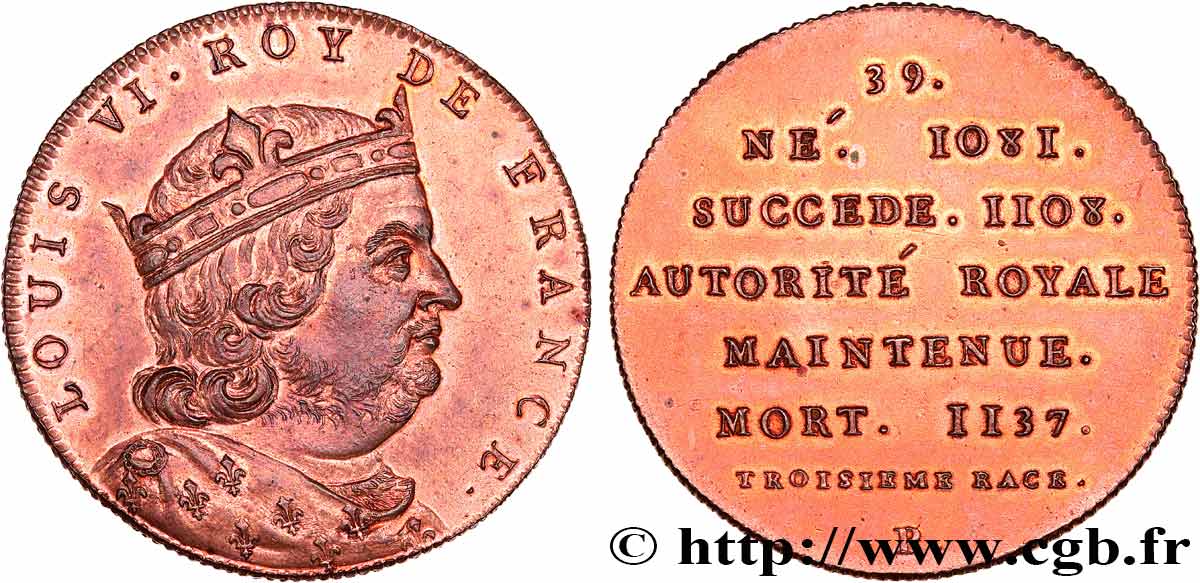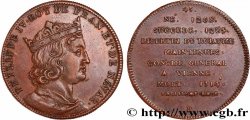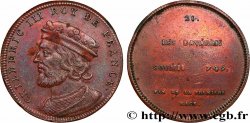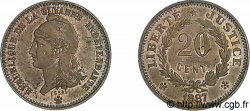Zurück 1/1
fjt_743442 - SÉRIE MÉTALLIQUE DES ROIS DE FRANCE Règne de LOUIS VI - 39 n.d.
35.00 €
Menge
In den Warenkorb

Type : Règne de LOUIS VI - 39
Datum: n.d.
Metall : Kupfer
Durchmesser : 32 mm
Stempelstellung : 12 h.
Gewicht : 14,23 g.
Rand Cannelée
Seltenheitsgrad : R2
Kommentare zum Erhaltungszustand:
Patine mate, usure sur l’avers
Pedigree :
Exemplaire provenant de la Collection MARINECHE
Vorderseite
Titulatur der Vorderseite LOUIS VI ROY DE FRANCE.
Beschreibung Vorderseite Buste imaginaire couronné et drapé à droite.
Rückseite
Titulatur der Rückseite 39 - NÉ 1081 - SUCCEDE 1108 - AUTORITÉ ROYALE MAINTENUE - MORT 1137 - TROISIEME RACE / P..
Beschreibung Rückseite en huit lignes.
Kommentare
Louis VI de France, dit le Gros ou le Batailleur, né en 1081, mort le 1er août 1137 au château royal de Béthisy - Saint - Pierre. Roi des Francs de juillet 1108 à 1137, il est le cinquième roi de la dynastie dite des Capétiens directs.
Il est le fils de Philippe Ier (1052-1108), roi des Francs et de sa première épouse Berthe de Hollande.
Après avoir répudié Berthe en 10924 et malgré les protestations du clergé, son père se remarie la même année avec Bertrade de Montfort, comtesse d'Anjou. De cette deuxième union naissent quatre enfants, dont deux fils. Louis, jeune prince issu du premier mariage de son père, est élevé avec Suger, futur abbé de Saint-Denis, qui devient son ami proche, puis son conseiller.
En 1092, son père l'investit du comté de Vexin et des villes de Mantes et de Pontoise. Il vit éloigné de la cour, sa mère ayant été répudiée et son père remarié à Bertrade de Montfort.
En 1097, à la tête de l'armée royale, il prend part à la guerre, défendant le Vexin contre Guillaume le Roux roi d'Angleterre.
Après avoir été adoubé chevalier le 24 mai 1098 à Abbeville, par Gui Ier comte de Ponthieu, Louis est associé au trône puis combat le duc de Normandie et les sires châtelains du domaine royal qui se montrent souvent rebelles à l'autorité royale.
Enfin son père, devenu impotent, incapable de gouverner et de combattre, se réconcilie avec lui. C'est dans le courant de l'année 11016 ou 11037, qu'il lui confie le gouvernement effectif du royaume en qualité de « rex designatus » (roi désigné) ; cette même année, il l'investit aussi du comté de Vermandois.
Pour la suite de la biographie, voir http://fr.wikipedia.org/wiki/Louis_VI_de_France.
Louis VI of France, known as the Fat or the Battler, born in 1081, died on August 1, 1137 at the royal castle of Béthisy-Saint-Pierre. King of the Franks from July 1108 to 1137, he was the fifth king of the dynasty known as the direct Capetians.
He is the son of Philip I (1052-1108), King of the Franks and his first wife Bertha of Holland.
After repudiating Berthe in 10924 and despite the protests of the clergy, her father remarried the same year with Bertrade de Montfort, Countess of Anjou. From this second union four children were born, including two sons.. Louis, a young prince from his father's first marriage, was raised with Suger, the future abbot of Saint-Denis, who became his close friend, then his advisor..
In 1092, his father invested him with the county of Vexin and the towns of Mantes and Pontoise.. He lived far from the court, his mother having been repudiated and his father remarried to Bertrade de Montfort..
In 1097, at the head of the royal army, he took part in the war, defending the Vexin against William Rufus, King of England..
After being knighted on May 24, 1098 in Abbeville, by Gui I, Count of Ponthieu, Louis was associated with the throne and then fought the Duke of Normandy and the lords of the royal domain who often showed themselves to be rebellious against royal authority..
Finally his father, having become impotent, incapable of governing and fighting, is reconciled with him. It was during the year 11016 or 11037 that he entrusted him with the effective government of the kingdom as \\\"rex designatus\\\" (designated king); that same year, he also invested him with the county of Vermandois..
For the rest of the biography, see http://fr. Wikipedia. org/wiki/Louis_VI_of_France
Il est le fils de Philippe Ier (1052-1108), roi des Francs et de sa première épouse Berthe de Hollande.
Après avoir répudié Berthe en 10924 et malgré les protestations du clergé, son père se remarie la même année avec Bertrade de Montfort, comtesse d'Anjou. De cette deuxième union naissent quatre enfants, dont deux fils. Louis, jeune prince issu du premier mariage de son père, est élevé avec Suger, futur abbé de Saint-Denis, qui devient son ami proche, puis son conseiller.
En 1092, son père l'investit du comté de Vexin et des villes de Mantes et de Pontoise. Il vit éloigné de la cour, sa mère ayant été répudiée et son père remarié à Bertrade de Montfort.
En 1097, à la tête de l'armée royale, il prend part à la guerre, défendant le Vexin contre Guillaume le Roux roi d'Angleterre.
Après avoir été adoubé chevalier le 24 mai 1098 à Abbeville, par Gui Ier comte de Ponthieu, Louis est associé au trône puis combat le duc de Normandie et les sires châtelains du domaine royal qui se montrent souvent rebelles à l'autorité royale.
Enfin son père, devenu impotent, incapable de gouverner et de combattre, se réconcilie avec lui. C'est dans le courant de l'année 11016 ou 11037, qu'il lui confie le gouvernement effectif du royaume en qualité de « rex designatus » (roi désigné) ; cette même année, il l'investit aussi du comté de Vermandois.
Pour la suite de la biographie, voir http://fr.wikipedia.org/wiki/Louis_VI_de_France.
Louis VI of France, known as the Fat or the Battler, born in 1081, died on August 1, 1137 at the royal castle of Béthisy-Saint-Pierre. King of the Franks from July 1108 to 1137, he was the fifth king of the dynasty known as the direct Capetians.
He is the son of Philip I (1052-1108), King of the Franks and his first wife Bertha of Holland.
After repudiating Berthe in 10924 and despite the protests of the clergy, her father remarried the same year with Bertrade de Montfort, Countess of Anjou. From this second union four children were born, including two sons.. Louis, a young prince from his father's first marriage, was raised with Suger, the future abbot of Saint-Denis, who became his close friend, then his advisor..
In 1092, his father invested him with the county of Vexin and the towns of Mantes and Pontoise.. He lived far from the court, his mother having been repudiated and his father remarried to Bertrade de Montfort..
In 1097, at the head of the royal army, he took part in the war, defending the Vexin against William Rufus, King of England..
After being knighted on May 24, 1098 in Abbeville, by Gui I, Count of Ponthieu, Louis was associated with the throne and then fought the Duke of Normandy and the lords of the royal domain who often showed themselves to be rebellious against royal authority..
Finally his father, having become impotent, incapable of governing and fighting, is reconciled with him. It was during the year 11016 or 11037 that he entrusted him with the effective government of the kingdom as \\\"rex designatus\\\" (designated king); that same year, he also invested him with the county of Vermandois..
For the rest of the biography, see http://fr. Wikipedia. org/wiki/Louis_VI_of_France








 Berichten über einen Fehler
Berichten über einen Fehler Die Seite drucken
Die Seite drucken Teilen meiner Auswahl
Teilen meiner Auswahl Stellen Sie eine Frage
Stellen Sie eine Frage Einlieferung/Verkauf
Einlieferung/Verkauf
 Details
Details















